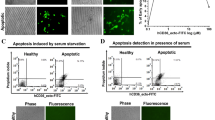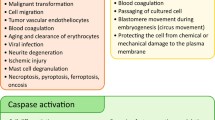Abstract
The sequential occurrence of plasma and mitochondrial membrane alterations, intra-cellular pH shifts and changes in intracellular Ca2+ concentration after induction of cell death was monitored by flow cytometry in Jurkat and HSB2-cells. Cell death was induced by treatment with anti-Fas antibodies or by irradiation. Phosphatidylserine (PS) exposure and plasma membrane integrity were measured with FITC-Annexin V adhesion and by Propidium Iodide exclusion. Transition of the mitochondrial membrane potential was monitored by the occurrence of decay of DiOC6 fluorescence. Intracellular pH shifts were monitored by changes in the ratio of fluorescence at 575 nm and at 635 nm of SNARF-1-AM. Fluctuations in intracellular Ca2+ concentration were established by changes in Fura red quenching.
The Jurkat cells were sensitive to anti-Fas treatment, while HSB-2 cells were not. HSB-2 cells appeared more sensitive to radiation damage than Jurkat cells.
In all experiments the transition of mitochondrial membrane potential occurred first, almost immediately followed by PS exposure. Fluctuations in intracellular Ca2+ concentration occurred later and were less outspoken. A decrease in intracellular pH occurred not earlier than 24 hours after anti-Fas treatment. Chelation of intracellular Ca2+ concentration with BAPTA-AM had no effect on the time sequence of cell death related events.
Similar content being viewed by others
References
Alnemeri ES, Livingston DJ, Nicholson DW, et al. Human ICE/CED-3 protease nomenclature. Cell 1996; 87: 171.
Cohen GM. Caspases: the executioners of apoptosis. Biochem J 1997; 326: 1-16.
Thornberry NA, Lazebnik Y. Caspases: Enemies within. Science 1998; 281: 1312-1316.
Ichas F, Mazat JP. From calcium signalling to cell death: two conformations for the mitochondrial permeability transition pore. Switching from low-to high-conductance state. Biochim Biophys Acta 1998; 1366: 33-50.
Susin SA, Zamzami N, Kroemer G. Mitochondria as regulators of apoptosis: doubt no more. Biochim Biophys Acta 1998; 1366: 151-165.
Susin SA, Lorenzo HK, Naoufal Z, et al. Molecular characterization of mitochondrial apoptosis-inducing factor. Nature 1999; 397: 441-446.
Fadok VA, Voelker DR, Campbell PA, Cohen JJ, Bratton DL, Henson PM. Exposure of phosphatidylserine on the surface of apoptotic lymphocytes triggers specific recognition and removal by macrophages. J Immunol 1992; 148: 2207-2216.
Uchiyama Y. Apoptosis: The history and trends of its studies. Arch Histol Cytol 1995; 58: 127-137.
VandenEijnde SM, Boshart L, Baehrecke EH, DeZeeuw CI, Reutelingsperger CPM, VermeijKeers C. Cell surface exposure of phosphatidylserine during apoptosis is phylogenetically conserved. Apoptosis 1998; 3: 9-16.
Berridge MJ, Bootman MD, Lipp P. Calcium—a life and death signal. Nature 1998; 395: 645-648.
Ashkenazi A, Dixit VM. Death receptors: signalling and modulation. Science 1998; 281: 305-1308.
Granville DJ, Carthy CM, Hunt DWC, McManus BM. Apoptosis: Molecular aspects of cell death and disease. Lab Invest 1998; 78: 893-913.
Green DR, Reed JC. Mitochondria and apoptosis. Science 1998; 281: 1305-1308.
Martin SJ, Green DR. Protease activation during apoptosis: Death by a thousand cuts? Cell 1995; 82: 349-352.
Vermes I, Haanen C. Apoptosis and programmed cell death in health and disease. Adv Clin Chem 1994; 31: 177-246.
Vermes I, Haanen C and Reutelingsperger CPM. Molecular biology of apoptosis and programmed cell death. In: Aruoma O, Halliwell B, eds. Free Radicals and Molecular Biology of Human Diseases. Chelsea: OICA International, Saint Lucia WI, GB, 1998: 225-286.
Darzynkiewicz Z, Bruno S, DelBino G, et al. Features of apoptotic cells measured by flow cytometry. Cytometry 1992; 13: 795-808.
Eastman A. Assays for DNA fragmentation, endonuclease and intracellular pH and Ca2+ associated with apoptosis. Meth Cell Biol 1995; 46: 41-55.
Vermes I, Haanen C, Steffens-Nakken H, Reutelingsperger CPM. A novel assay for apoptosis. Flow cytometric detection of phosphatidylserine expression on early apoptotic cells using fluorescein labelled Annexin V. J Immunol Meth 1995; 184: 39-51.
Overbeeke R, Steffens-Nakken H, Vermes I, Reutelingsperger C, Haanen C. Early features of apoptosis detected by four different flow cytometry assays. Apoptosis 1998; 3: 115-121.
Marchetti P, Castedo M, Susin SA, et al. Mitochondrial permeability transition is a central coordinating event of apoptosis. J Exp Med 1996; 184: 1155-1160.
Lennon SV, Kilfeather SA, Hallett MB, Campbell AK, Cotter TG. Elevations in cytosolic free Ca2+ are not required to trigger apoptosis in human leukaemia cells. Clin Exp Immunol 1992; 157: 4830-4836.
Ishaque A, Al-Rubeai M. Use of intracellular pH and annexin-V flow cytometry assays to monitor apoptosis and its suppression by bcl-2 over-expression in hybridoma cell culture. J Immunol Meth 1998; 221: 43-57.
Hampton MB, Vanags DM, Pörn-Ares I, Orrenius S. Involvement of extracellular calcium in phosphatidylserine exposure during apoptosis. FEBS Lett 1996; 399: 277-282.
McKenna WG, Berhard EJ, Maarkiewicz DA, Rudoltz MS, Maity A, Muschel RJ. Regulation of radiation-induced apoptosis in oncogene-transfected fibroblasts: influence of H-ras on the G2 delay. Oncogene 1996; 18: 237-245.
Kyprianou N, King ED, Bradbury D, Rhee JG. Bcl-2 over-expression delays radiation-induced apoptosis without affecting the clonogenic survival of human prostate cancer cells. Int J Cancer 1997; 70: 341-348.
Aldridge DR, Radford IR. Explaining differences in sensitivity to killing by ionizing radiation between human lymphoid cell lines. Cancer Res 1998; 58: 2817-2824.
Backway KL, McCulloch EA, Chow S, Hedley DW. Relationships between the mitochondrial permeability transition and oxidative stress during ara-C toxicity. Cancer Res 1997; 57: 2446-2451.
Castedo M, Hirsch T, Susin SA, et al. Sequential acquisition of mitochondrial and plasma membrane alterations during early lymphocyte apoptosis. J Immunol 1996; 157: 512-521.
Marchetti P, Hirch T, Zamzami N, et al. Mitochondrial permeability transition triggers lymphocyte apoptosis. J Immunol 1996; 157: 4830-4836.
Author information
Authors and Affiliations
Rights and permissions
About this article
Cite this article
Overbeeke, R., Yildirim, M., Reutelingsperger, C.P.M. et al. Sequential occurrence of mitochondrial and plasma membrane alterations, fluctuations in cellular Ca2+ and pH during initial and later phases of cell death. Apoptosis 4, 455–460 (1999). https://doi.org/10.1023/A:1009604510329
Issue Date:
DOI: https://doi.org/10.1023/A:1009604510329




